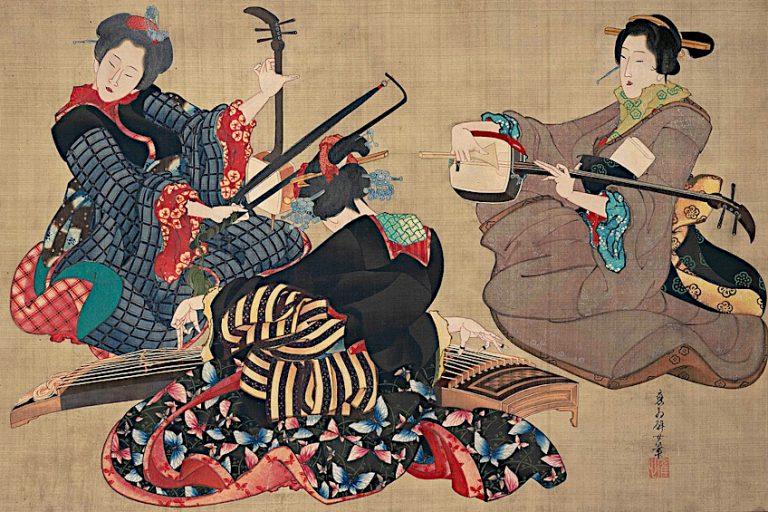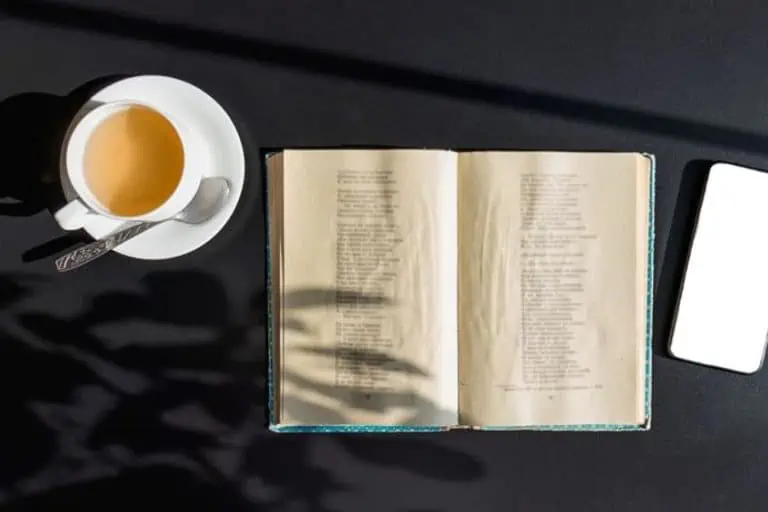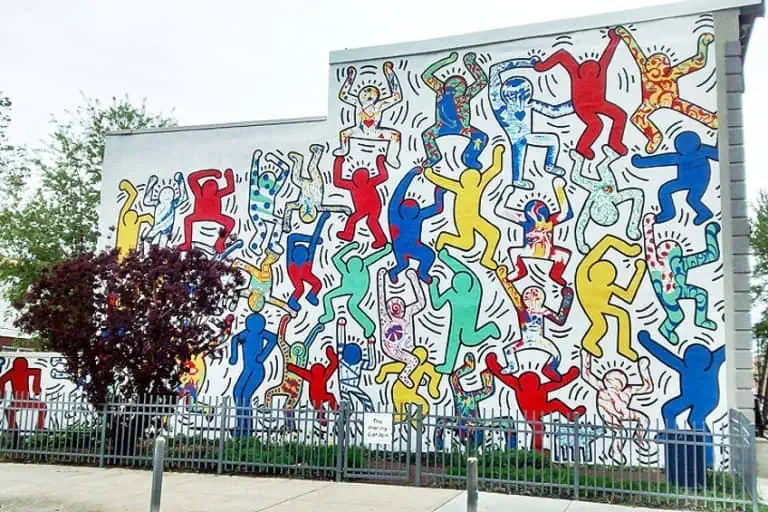Orientalism Art – An In-Depth Guide to Orientalism Art History
This post may contain affiliate links. We may earn a small commission from purchases made through them, at no additional cost to you.
The Orient, a term referring to the countries of the East, such as East Asia and the Middle East, became connected with the exotic in the minds of people in the West and provided artists with an abundance of subject matter during the 19th century. The Western world is known for often being fascinated by other cultures, borrowing inspiration from their traits, styles, or artifacts, and stereotypically representing them. Below we will discuss what Orientalism is, some of the key artists of this movement, and their famous works of art.
Table of Contents
- 1 What Is Orientalism?
- 2 Orientalist Artists and Their Artworks
- 2.1 Jean-Auguste-Dominique Ingres (1780 – 1867)
- 2.2 Horace Vernet (1789 – 1863)
- 2.3 Eugène Delacroix (1798 – 1863)
- 2.4 John Frederick Lewis (1804 – 1876)
- 2.5 Jean-Léon Gérôme (1824 – 1904)
- 2.6 Gustave Moreau (1826 – 1898)
- 2.7 William Holman Hunt (1827 – 1910)
- 2.8 Henriette Browne (1829 – 1901)
- 2.9 Osman Hamdi Bey (1842 – 1910)
- 3 Frequently Asked Questions
What Is Orientalism?
The Orientalism definition as a noun is essentially a representation or depiction of the Eastern world in a way that is stereotypical and viewed as representing a colonialist attitude. In art history, Orientalism refers to paintings, decorative arts, and architecture created by people in the West, such as the English or French, during the 19th century that uses places, artifacts, and themes drawn from countries of the East, such as Egypt, India, Algeria, China, and Turkey.
Some artists chose to depict these scenes realistically, while others represented the culture and practices of the Orient in a romanticized way infused with fantasy.
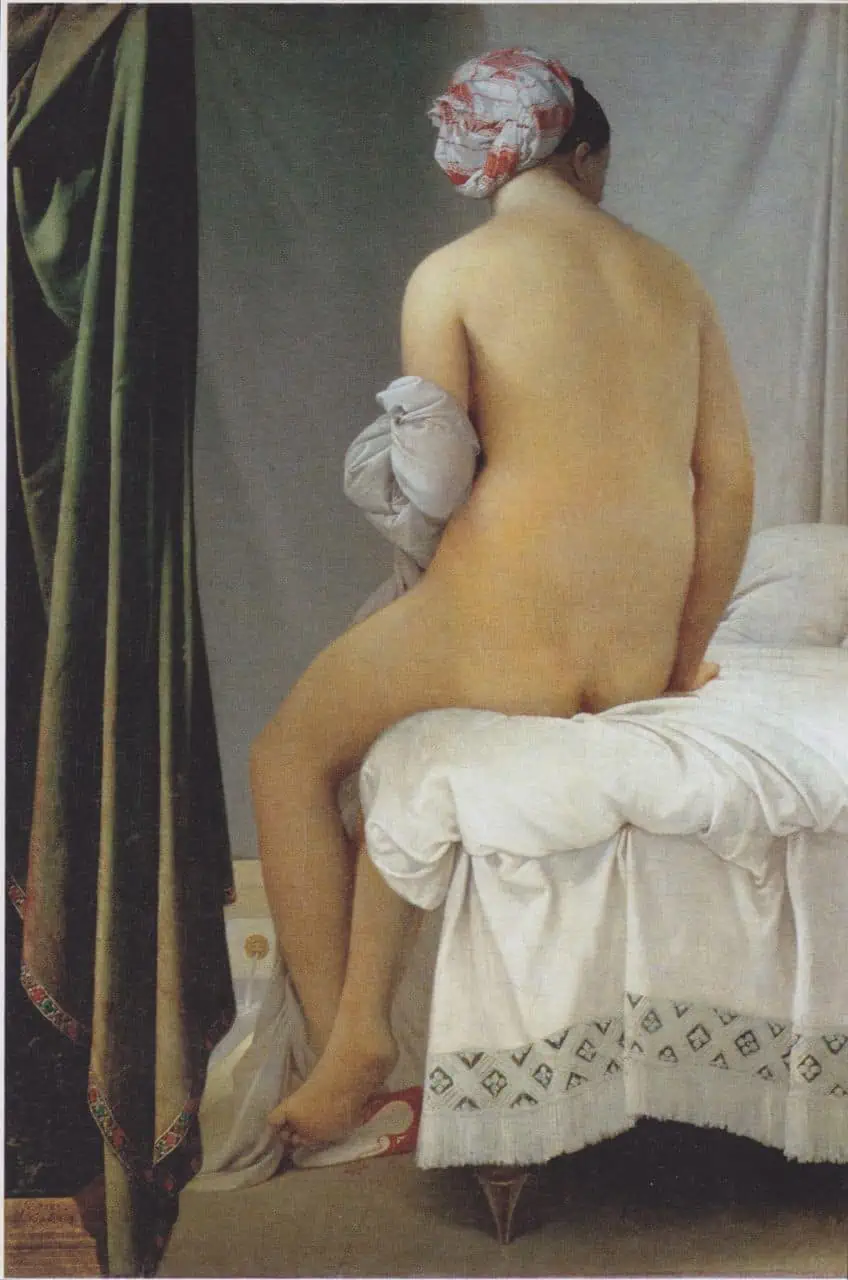 La Grande Baigneuse (1808) by Jean Auguste Dominique Ingres; Jean Auguste Dominique Ingres, Public domain, via Wikimedia Commons
La Grande Baigneuse (1808) by Jean Auguste Dominique Ingres; Jean Auguste Dominique Ingres, Public domain, via Wikimedia Commons
Travel to Distant Lands
An Orientalist artwork functioned as a visual record of distant lands that interested people of the West. This interest grew at the same time as Europeans were colonizing various parts of the world, which allowed artists, soldiers, and traders easier access to these places and their inhabitants. Many artists visited the places that they painted, while others, known as armchair Orientalists, used their imagination, props, and photographs for inspiration. The images that they painted were targeted at a growing market of Westerners who were either interested in North Africa or the Middle East or had visited there.
Trains and steamships made traveling easier and artists often focused on cities such as Cairo, Constantinople, and Marrakesh, sometimes painting both Christian and Muslim religious sites, while other artists depicted ancient locations such as the Egyptian pyramids.
The Difference Between Oriental Artists and Orientalist Artists
Today, Oriental art most commonly refers to art originating from China, Japan, Korea, India, and Central and Southeast Asia. Oriental artists often reflect the culture and society in which they created their Oriental paintings or artwork. Orientalist paintings are therefore not Oriental paintings because the artist is from the West and has depicted aspects of a culture from the East that is not their own.
 Edfu, Upper Egypt (1860) by John Frederick Lewis; John Frederick Lewis, Public domain, via Wikimedia Commons
Edfu, Upper Egypt (1860) by John Frederick Lewis; John Frederick Lewis, Public domain, via Wikimedia Commons
In history, Oriental art was also used to classify Byzantine, traditional African art, and pre-Columbian American art under the same umbrella, a result of the Eurocentric view that placed all foreign cultures under one concept, irrespective of their individuality. For a long time, the term, Oriental was used to describe geographical locations and cultures opposite to Western or occidental cultures. But the Orient came to have various meanings and connotations at different times in history, a confusion brought about by the Westerners’ misunderstanding of the East’s geographical scale.
Today, critics often prefer to use a different term for “oriental” and suggest using more location-specific descriptions.
Key Concepts of Orientalism
Many Orientalist paintings included rich colors such as reds, golds, and oranges. The combination of these colors with decorative details, and light and shadow created a sense of warmth that was associated with the Orient. One of the most popular scenes for Orientalists was the picture of the harem, a part of the Muslim household in earlier times that was kept separate for wives, concubines, and servants that were female. Because male artists were denied access to these women’s apartments, they relied on rumors and their wild imaginations to depict beautiful women in lavish interior spaces, and many of these women were portrayed with a Western appearance.
Interestingly, this genre of painting allowed the artists to explore narratives within an exotic setting that was not generally acceptable in the eyes of the West, depicting sexual scenes and erotic nudes that were usually reserved for mythological settings.
Orientalism art helped to spread and strengthen a variety of stereotypes and misconceptions regarding cultures of the East, such as moral differences, their “uncivilized” behavior, and their sexual practices. This can be understood within the context of the economic and political relationships that Europe had with Eastern countries at the time of colonization.
Orientalist Artists and Their Artworks
Many painters contributed to Orientalism art history during the 19th century and although we cannot fit them all into one article, we have listed some important and interesting artists of the period and their artworks below. With their ability to combine imagination with reality, these artists convinced Western viewers with their intriguing subject matter, rich color palettes, and detailed rendering.
 The Tortoise Trainer (1906) by Osman Hamdi Bey; Osman Hamdi Bey, Public domain, via Wikimedia Commons
The Tortoise Trainer (1906) by Osman Hamdi Bey; Osman Hamdi Bey, Public domain, via Wikimedia Commons
Jean-Auguste-Dominique Ingres (1780 – 1867)
| Artist | Jean-Auguste-Dominique Ingres |
| When the Artist Lived | 1780 – 1867 |
| Nationality of the Artist | French |
| Where the Artist Lived | France |
| Associated Art Movements | Neoclassicism, Romanticism |
Jean-Auguste-Dominique Ingres was a French painter and draughtsman who was heavily influenced by historical artistic traditions such as the Classical and Renaissance art periods. He is known for his meticulous drawing skills and rendering of textures. His experimentation with the abstraction of form and the introduction of exotic subjects to his compositions was not well accepted early in his career, however, his experimentation with distortion foreshadowed that of Modernism in the 20th century.
It was during the more dramatic Romanticism period that Ingres’ classical style of painting came to be widely recognized.
Grande Odalisque (1814) by Jean-Auguste-Dominique Ingres
| Date Completed | 1814 |
| Dimensions (cm) | 88.9 x 162.56 |
| Medium | Oil on canvas |
| Where It Is Currently Housed | Louvre Museum |
Grande Odalisque (1814) is an oil painting that was commissioned by Queen Caroline Murat of Naples. It is believed by Ingres’ contemporaries that this work marked the shift in the artist’s style from Neoclassicism to Romanticism. The female nude is an odalisque or concubine reclining on what seems to be a couch with cushions and luxurious drapery while she looks over her shoulder at the viewer.
Various elements within the work, combining Babylonian and Turkish iconography, suggest that she is in a harem: She is holding a peacock feather in her right hand, a hashish pipe lying at her feet, and she is wearing a vibrant turban on her head.
The figure is a European woman that has been placed in an Oriental setting, the erotic nature of the work made acceptable because of its exotic environment. The curvature of the figure’s spine is exaggerated, and her right arm is longer than the other. The distortions of the body are intended to stimulate the viewer’s erotic eye and evoke an emotional effect, while the line and refined finish create a sense of objectivity as if the viewer is merely observing.
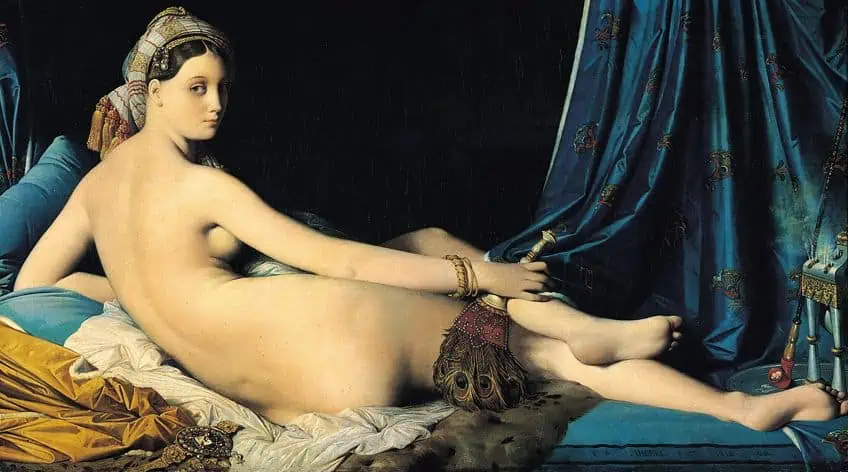 Grande Odalisque (1814) by Jean-Auguste-Dominique Ingres; Jean Auguste Dominique Ingres, Public domain, via Wikimedia Commons
Grande Odalisque (1814) by Jean-Auguste-Dominique Ingres; Jean Auguste Dominique Ingres, Public domain, via Wikimedia Commons
Some of Jean-Auguste-Dominique Ingres’s other works include:
- The Valpinçon Bather (1808)
- Jupiter and Thetis (1811)
- Odalisque with Slave (1839)
- The Source (1856)
Horace Vernet (1789 – 1863)
| Artist | Horace Vernet |
| When the Artist Lived | 1789 – 1863 |
| Nationality of the Artist | French |
| Where the Artist Lived | France |
| Associated Art Movements | Romanticism, Neoclassicism, Academic art |
Horace Vernet or Émile Jean-Horace Vernet in full was a French painter who depicted battles, scenes of the Orient, and portraits. His father, Carle Vernet, and his grandfather, Joseph Vernet were two well-established painters and Vernet acquired their talent and developed an eye for detail. He was known for painting on a large scale and became one of the most notable military painters in France. Some of his paintings of the Arab world were inspired by his time spent with the French army in Algiers in 1833.
His works depicting the Middle East often highlighted the military in all its glory, however, some also depicted scenes of a more intimate, relaxed nature as seen below.
The Arab Tale Teller (1833) by Horace Vernet
| Date Completed | 1833 |
| Dimensions (cm) | 99 x 136.5 |
| Medium | Oil on canvas |
| Where It Is Currently Housed | The Wallace Collection |
The Arab Tale Teller (1833) is an oil painting of a hilly landscape in the background, with a group of male figures seated in a half circle in the foreground. They are sitting beneath a tree and listening intently to the taleteller. Horses can be seen on the right of the composition along with a few huts and tents, while a woman stands on the left-hand side of the composition holding a jug in a classical pose possibly taken from the Venus de Milo (c. 150-125 BC) by Alexandros of Antioch. Almost all the men in the painting are dressed in white burnouses traditionally worn in Algeria, while the taleteller is dressed in a grey burnouse with white stripes. The scene is washed in a warm hue, giving the sense of heat. Verne painted the work in Rome shortly after visiting Algeria in 1833.
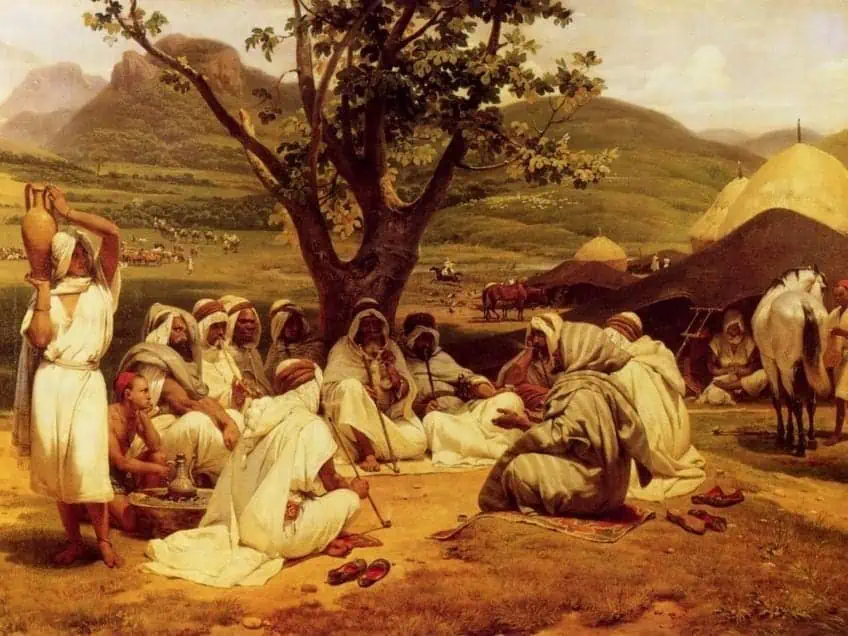 The Arab Tale Teller (1833) by Horace Vernet; Horace Vernet, Public domain, via Wikimedia Commons
The Arab Tale Teller (1833) by Horace Vernet; Horace Vernet, Public domain, via Wikimedia Commons
Some of Horace Vernet’s other works include:
- Arab Warrior (1817-1822)
- The Lion Hunter (1833)
- The Lion Hunt (1836)
- Juda et Thamar (1840)
Eugène Delacroix (1798 – 1863)
| Artist | Eugène Delacroix |
| When the Artist Lived | 1798 – 1863 |
| Nationality of the Artist | French |
| Where the Artist Lived | France |
| Associated Art Movements | Romanticism, Romanesque art |
Eugène Delacroix was a French artist who is regarded as the front-runner of the Romantic art movement. His work is characterized by vivid color and exuberant brushwork and exemplifies the Romantic movement’s interest in emotion and exoticism. Delacroix favored scenes from contemporary history and literature as his choice of subject, depicting them in a dramatic way.
Many of his works were based on his observation of nature and wildlife, which he combined with an imagined narrative.
The Death of Sardanapalus (1827) by Eugène Delacroix
| Date Completed | 1827 |
| Dimensions (cm) | 392 x 496 |
| Medium | Oil on canvas |
| Where It Is Currently Housed | Louvre Museum |
The Death of Sardanapalus (1827) is a large-scale oil painting depicting the moment before the suicide of the Assyrian King, Sardanapalus. The king had ordered that his palace possessions be destroyed after hearing of his army’s defeat, including the death of his slaves, women, and favorite concubine. The sense of drama and chaos depicted in this painting is achieved through Delacroix’s composition, with movement and emotion expressed in various parts of the picture.
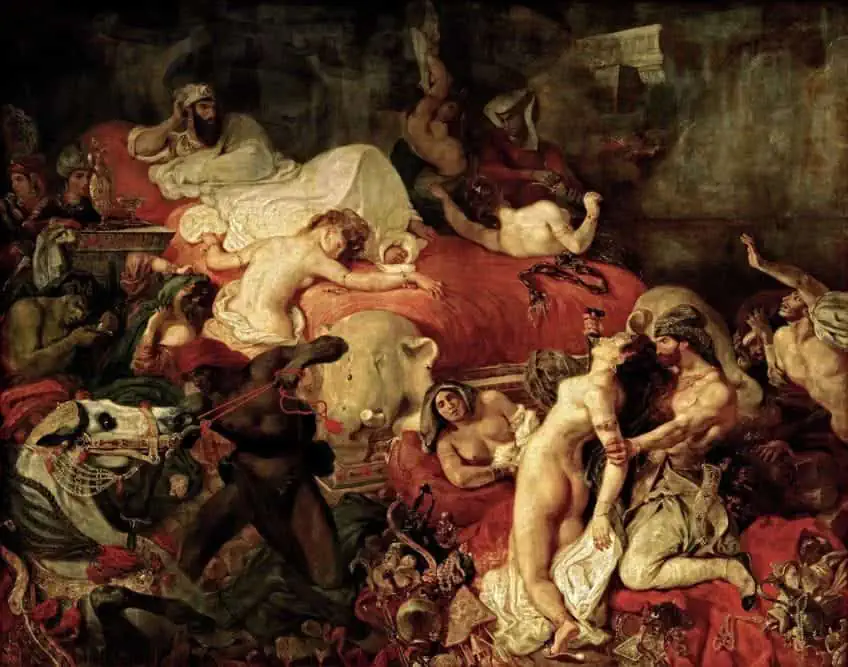 The Death of Sardanapalus (1827) by Eugène Delacroix; Eugène Delacroix, Public domain, via Wikimedia Commons
The Death of Sardanapalus (1827) by Eugène Delacroix; Eugène Delacroix, Public domain, via Wikimedia Commons
The king is reclining on a large red bed, surrounded by disorder and turmoil as his orders are carried out in front of him. A half-nude female slave is slumped on the bed next to him, while another slave is held by a male attendant, about to be killed. Horses in the left bottom corner of the composition rear in fear as a male slave struggles to control them. Luxurious fabrics, gold, and jewelry are scattered about the room, which will all be burned on the funeral pyre. The use of red in this painting signifies luxury as well as blood and violence, while the artist’s painterly brushstrokes give the scene energy and enhance the sense of chaos. Some of Eugène Delacroix’s other works include:
- The Massacre at Chios (1824)
- Liberty Leading the People (1830)
- Women of Algiers in their Apartment (1834)
- Lion Hunt (1861)
John Frederick Lewis (1804 – 1876)
| Artist | John Frederick Lewis |
| When the Artist Lived | 1804 – 1876 |
| Nationality of the Artist | British |
| Where the Artist Lived | England, Egypt |
| Associated Art Movements | Orientalism |
John Frederick Lewis was an English painter who depicted scenes of the Mediterranean and the Orient using watercolor or oil paint, often painting a version of the same composition in both mediums. He lived in Cairo, Egypt for about 10 years before returning to his home country of England in 1851. His work is characterized by highly detailed realistic scenes of life in the Middle East, as well as romanticized depictions of the upper-class interiors of Egypt. He influenced other Orientalist artists, such as Jean-Léon Gérôme with his realistic representation of Islamic furnishings, architecture, and costumes.
Interestingly, unlike other Orientalist painters of the time, Lewis never painted a nude female figure. And when he painted harem scenes, his wife often modeled for him.
A Lady Receiving Visitors (The Reception) (1873) by John Frederick Lewis
| Date Completed | 1873 |
| Dimensions (cm) | 63.5 x 76.2 |
| Medium | Oil on panel |
| Where It Is Currently Housed | Yale Center for British Art |
A Lady Receiving Visitors (The Reception) (1873) is a scene from an apartment in a house in Cairo. The entire composition is painted with care and precision, from the detailed patterns of fabrics and stained glass, fretwork design, reflections in the bath water, and the small gazelle, to the decorated tiles.
In the work, Lewis depicts the lady of the house reclining on a royal blue window seat, while visiting ladies are being presented to her on the left of the composition.
While the painting aims to reveal how the harem truly was, liberties have been taken with the details. For example, the original title of the work included the term, mandarah which is a space on the first floor of an Egyptian household that was used to receive male visitors. However, the room depicted here is the qa’a, a reception room that was set aside for women upstairs.
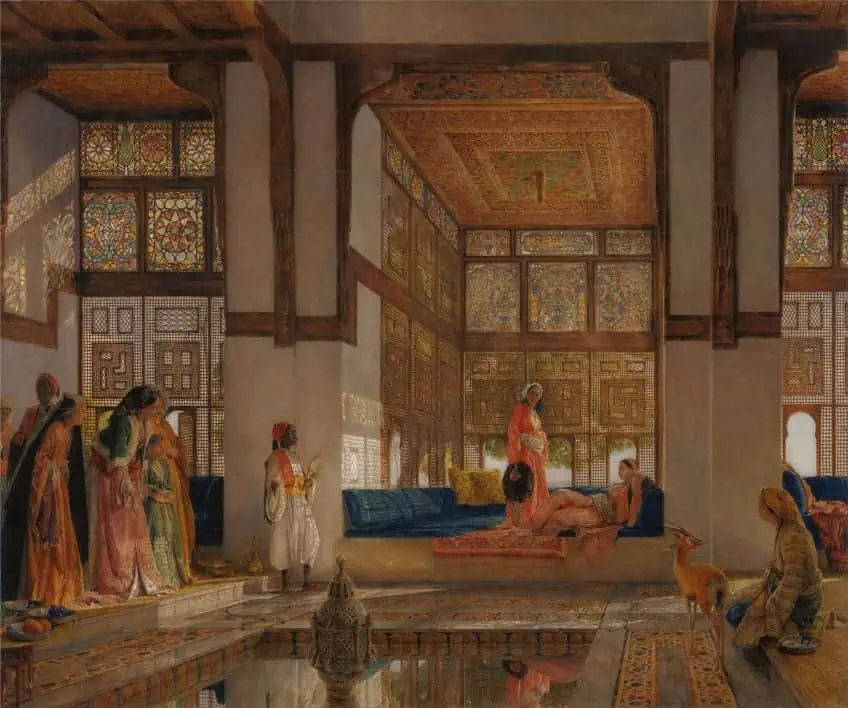 A Lady Receiving Visitors (The Reception) (1873) by John Frederick Lewis; John Frederick Lewis, Public domain, via Wikimedia Commons
A Lady Receiving Visitors (The Reception) (1873) by John Frederick Lewis; John Frederick Lewis, Public domain, via Wikimedia Commons
Some of John Frederick Lewis’ other works include:
- The Pipe Bearer (1856)
- Edfu, Upper Egypt (1860)
- The Doubtful Coin (1869)
- The Harem (1876)
Jean-Léon Gérôme (1824 – 1904)
| Artist | Jean-Léon Gérôme |
| When the Artist Lived | 1824 – 1904 |
| Nationality of the Artist | French |
| Where the Artist Lived | France |
| Associated Art Movements | Academic art or Academicism |
Jean-Léon Gérôme is a French painter and sculptor who created art in the style of Academicism. Of his generation, Gérôme is one of the most famous French artists, with his careful attention to detail and ability to captivate viewers with his spectacular and dramatic narratives, he transformed historical painting. However, the worlds that he depicted should not be relied on for historical accuracy. Gérôme was criticized by artists, such as Realists and Expressionists, for mixing genre painting with academic painting, considering the two schools to be old-fashioned, with his style falling somewhere in between them. Although his skill did not win the favor of his seniors, everyday people purchased reproductions of his work in large quantities.
His paintings were so detailed and precise that the fantastical images of the Orient that he depicted seemed authentic and thus became very popular with the public.
The Snake Charmer (1879) by Jean-Léon Gérôme
| Date Completed | 1879 |
| Dimensions (cm) | 82.2 x 121 |
| Medium | Oil on canvas |
| Where It Is Currently Housed | Sterling and Francine Clark Art Institute |
The Snake Charmer (1879) is a good representation of Gérôme’s highly realistic and decorative style. The painting depicts a young boy holding a python in front of 10 men wearing Islamic tribal clothing, while an old man to his right plays a recorder. Apart from the reptile, which is wrapped around his body, the boy is completely nude. The men on the floor are holding weapons and staffs as they sit against a wall that is beautifully tiled in an eastern style with aquamarine, azure, turquoise, and cyan. The painting was inspired by Gérôme’s visit to Constantinople, and like many of his works, it was made up of a combination of studies that he made while traveling.
Therefore, there are some errors, and “The Snake Charmer” has been met with criticism for its overly fantasized portrayal of the far East.
 The Snake Charmer (1879) by Jean-Léon Gérôme; Jean-Léon Gérôme, Public domain, via Wikimedia Commons
The Snake Charmer (1879) by Jean-Léon Gérôme; Jean-Léon Gérôme, Public domain, via Wikimedia Commons
Some of Jean-Léon Gérôme’s other works include:
- The Slave Market (1866)
- Bashi-Bazouk (1869)
- Bathsheba (1889)
- The Carpet Merchant (1892)
Gustave Moreau (1826 – 1898)
| Artist | Gustave Moreau |
| When the Artist Lived | 1826 – 1898 |
| Nationality of the Artist | French |
| Where the Artist Lived | France |
| Associated Art Movements | Symbolism, Romanticism, Modern art |
Gustave Moreau was a French painter whose work made a significant impact on the Symbolist movement and anticipated the Surrealist movement. His religious faith, known as Neoplatonism, emphasized that the world is impermanent and imperfect, and this view influenced his work which is full of imagination and otherworldly subjects, as well as a fascination with the macabre. He believed that he was painting from divine revelation and depicted Mythic or Biblical narratives, filled with symbolism.
These symbols were considered by Moreau as representing emotions and desires, revealing the darkest yearnings of the human mind.
The Apparition (1876) by Gustave Moreau
| Date Completed | 1876 |
| Dimensions (cm) | 720 x 1060 |
| Medium | Watercolor |
| Where It Is Currently Housed | Louvre Museum |
The Apparition (1876) is a watercolor painting depicting Salomé, a Judaean princess who is very much the femme fatale in this painting. According to the Biblical story, she danced for her mother’s husband, King Herod, bewitching him with her sensual movements. As a reward, Salomé won John the Baptist’s head. It is not clear as to which moment this painting refers, as Salomé could be dancing, or the scene could be a premonition of the horrifying outcome or even a reminder of the deed already committed.
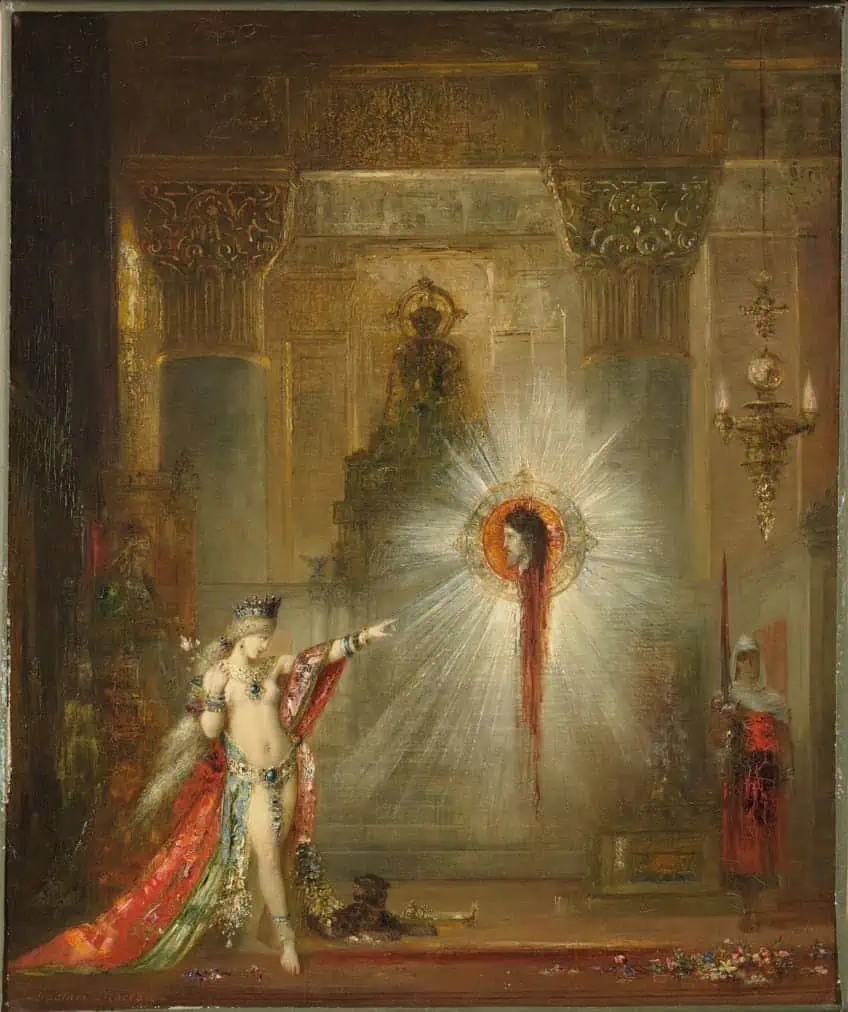 The Apparition (1876) by Gustave Moreau; Gustave Moreau, Public domain, via Wikimedia Commons
The Apparition (1876) by Gustave Moreau; Gustave Moreau, Public domain, via Wikimedia Commons
The head of John the Baptist floats in the air surrounded by a halo as the princess points her hand towards it, her body positioned as if she were mid-dance. The other figures in the composition are solemn and still. The robes and headdresses worn in the painting may be influenced by Moreau’s reading of orientalist literature at the time.
He often used Asian and Indian dress, architecture, and art as points of reference to create a mysterious, exotic atmosphere in his work.
Some of Gustave Moreau’s other works include:
- The Infant Moses (1878)
- The Triumph of Alexander the Great (1892)
- Song of Songs (Cantique des Cantiques) (1893)
- Salomé Dancing Before the Head of St. John the Baptist (1898)
William Holman Hunt (1827 – 1910)
| Artist | William Holman Hunt |
| When the Artist Lived | 1827 – 1910 |
| Nationality of the Artist | British |
| Where the Artist Lived | England |
| Associated Art Movements | Pre-Raphaelite Brotherhood |
William Holman Hunt was an English painter and one of the founding members of the Pre-Raphaelite Brotherhood. He was a religious man with strong Christian beliefs and would use many locations from the Middle East to tell Biblical stories in his paintings. Hunt’s works were known for his use of symbolism, great attention to detail, and use of vivid colors. He preferred to create less romantic art; he believed in spiritual truth and that it was the task of the artist to portray things truthfully while using art to encourage moral integrity. He was inspired by medieval and religious stories depicted in Florentine and Sienese paintings in the 15th century and their symbolism.
Hunt took much responsibility for himself to spread the word of God through his art and depicted Bible stories in a bold realistic manner.
The Finding of the Savior in the Temple (1860) by William Holman Hunt
| Date Completed | 1860 |
| Dimensions (cm) | 141.0 x 85.7 |
| Medium | Oil on canvas |
| Where It Is Currently Housed | Birmingham Museum & Art Gallery |
Hunt’s work, The Finding of the Savior in the Temple (1860) depicts a scene from the Bible when Mary and Joseph find Jesus in the Temple with the rabbis, where he was debating the interpretation of the scripture with them. In the painting, Mary and Joseph hold Jesus, while the rabbis react in various ways to what he has just said to them. For this painting, Hunt traveled to The Holy Land of Israel in the Middle East so that he could paint the work with ethnographical accuracy, presenting the culture and people how he saw them. The subjects are portrayed with elegant, colorful clothing and the temple is ornate and detailed. The figures are not wearing shoes, and many are sitting on the ground with no tables or chairs.
The rabbis wear headdresses and long robes, their beards long and characteristic of Orientalist depictions of Arab men at the time.
 The Finding of the Savior in the Temple (1860) by William Holman Hunt; William Holman Hunt, Public domain, via Wikimedia Commons
The Finding of the Savior in the Temple (1860) by William Holman Hunt; William Holman Hunt, Public domain, via Wikimedia Commons
Some of William Holman Hunt’s other famous works include:
- The Light of the World (1854)
- The Scapegoat (1856)
- Isabella and the Pot of Basil (1868)
- The Shadow of Death (1873)
Henriette Browne (1829 – 1901)
| Artist | Henriette Browne |
| When the Artist Lived | 1829 – 1901 |
| Nationality of the Artist | French |
| Where the Artist Lived | France |
| Associated Art Movements | Orientalism |
Henriette Browne is the better-known pseudonym for the French Orientalist painter, Sophie de Bouteiller. She was one of the few female Orientalist artists that painted during the 19th century.
Her paintings held the same exotic subject matter that was popular amongst her contemporaries, but they were less exaggerated and she was known for her alternative approach to Orientalist painting.
A Visit: A Harem Interior (1860) by Henriette Browne
| Date Completed | 1860 |
| Dimensions (cm) | 29.5 x 41cm |
| Medium | Oil on canvas |
| Where It Is Currently Housed | Private Collection |
Browne’s oil painting, A Visit: A Harem Interior (1860) depicts a scene that was often overworked and oversexualized within the Orientalist movement. However, this painting is rare and considered important because Browne depicts the harem differently, as a sophisticated space for women that was out of reach of the male gaze. The painting was based on her own experience visiting the Orient and as a woman, being allowed access to the harem.
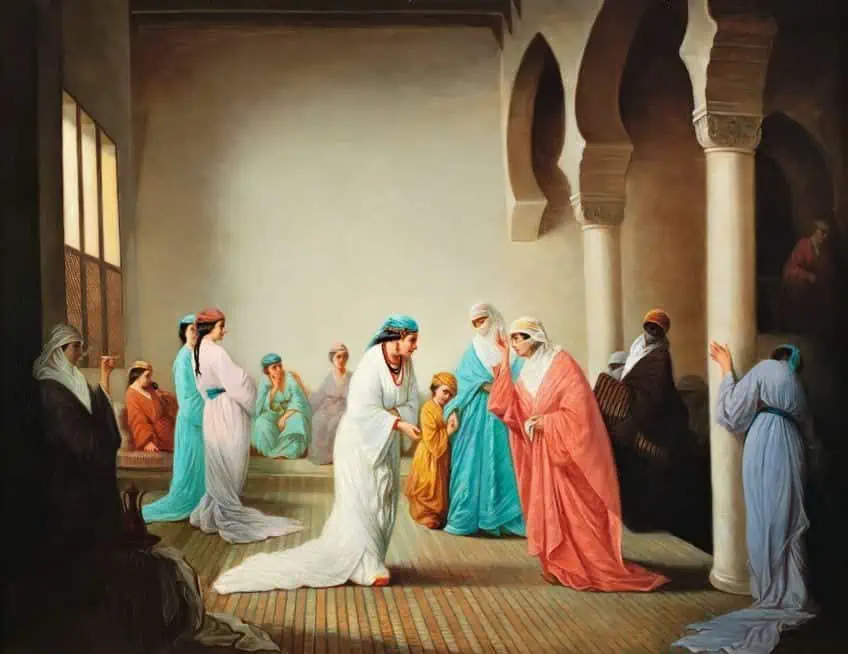 A Visit: A Harem Interior (1860) by Henriette Browne; Henriette Browne, Public domain, via Wikimedia Commons
A Visit: A Harem Interior (1860) by Henriette Browne; Henriette Browne, Public domain, via Wikimedia Commons
The work portrays the interior of this space with no sexual connotation and with minimal decoration. She depicts a harem visiting another, with one group of women’s faces lightly covered with yashmaks entering their hostess’ apartment. It is sparsely furnished, and the visiting women have brought their own cushions. One visitor approaches them with the usual greeting of the time, gesturing with her right hand, and touching her forehead, mouth, and chest. A child clings to a woman who could be their mother in the background.
Some of Henriette Browne’s other works include:
- Man Sewing (n.d.)
- An Oriental Beauty (1861)
- A Greek Captive (1863)
- A Girl Writing. The Pet Goldfinch Painting (1874)
Osman Hamdi Bey (1842 – 1910)
| Artist | Osman Hamdi Bey |
| When the Artist Lived | 1842 – 1910 |
| Nationality of the Artist | Turkish |
| Where the Artist Lived | Turkey, France |
| Associated Art Movements | Romanticism |
Osman Hamdi Bey was a Turkish painter, Ottoman administrator, poet, and art expert who painted the East in the European academic style. He is given much praise for developing an understanding between Islamic culture and the West. Having been born in Istanbul, he received his artistic training in Paris, tutoring under Gustave Boulanger.
Hamdi Bey painted almost solely for a Western audience and nearly never showed his work in Turkey, but while other European Orientalists sought to depict the near-east with an exaggerated, dramatized representation, he portrayed it with more accuracy and in a noble, respectful way, while still including clichés.
Koranic Instruction (1890) by Osman Hamdi Bey
| Date Completed | 1890 |
| Dimensions (cm) | 80 x 60 |
| Medium | Oil on canvas |
| Where It Is Currently Housed | Private Collection |
Koranic Instruction (1890) is an oil painting depicting an Hoja (teacher) giving Koranic instruction to a pupil sitting in a section of the Yesil Cami or Green Mosque at Bursa in Western Anatolia. A Mamluk lantern hangs in the top left corner of the composition and an enormous Mamluk candlestick stands behind the Hoja on the right. This work shows many characteristics of French academic painting, true-to-life and well composed, but it was an important work that challenged the social and artistic standards of the day, such as figurative painting, which Muslim artists hardly practiced at the time.
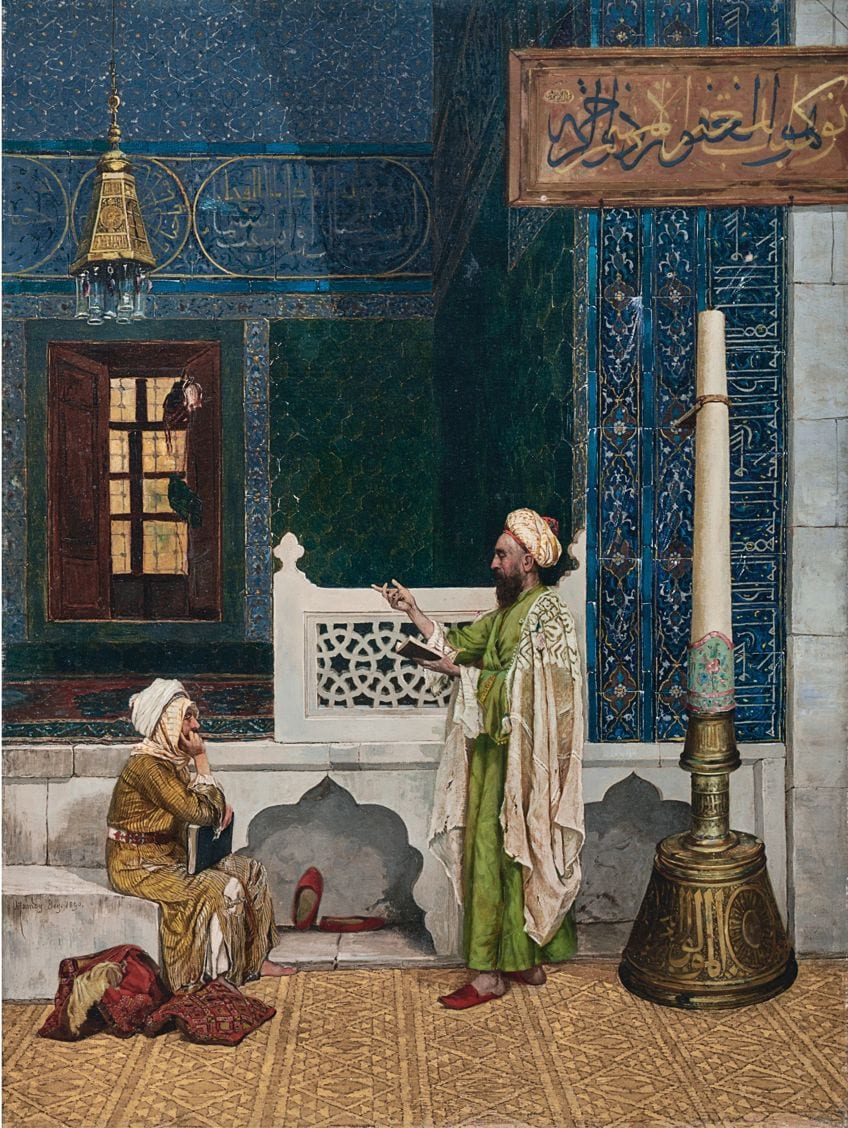 Koranic Instruction (1890) by Osman Hamdi Bey; Osman Hamdi Bey, Public domain, via Wikimedia Commons
Koranic Instruction (1890) by Osman Hamdi Bey; Osman Hamdi Bey, Public domain, via Wikimedia Commons
Hamdi Bey used his paintings as a medium for social commentary, often criticizing his home country’s conservative practices. In this work, he includes small details that challenge the Koranic’s honorable profession, such as the slippers that he wears even though he should traditionally be barefoot inside the mosque. The pupil’s slippers are casually tossed in the nook beneath the alcove, and he looks as though he is about to fall asleep.
Some of Osman Hamdi Bey’s other works include:
- A Young Emir Studying (1878)
- The Musician Girls (1880)
- The Tortoise Trainer (1906)
- Gun Salesman (1908)
In closing, Orientalism art greatly impacted the way that the world viewed the Orient as it was borne out of colonialism, consumerism, and the fascination that the West had with foreign cultures. The exotic imagery that was produced depicting distant lands and peoples was the product of the imaginative fantasies of the artists and Europeans. This resulted in a racialized and sexualized representation of the Orient, with its people being portrayed as either passive, uncivilized, or licentious. In this way, Orientalist artworks helped to spread propaganda and further European ideology. If you found this article on Orientalism insightful, we encourage you to continue your exploration of Orientalism art history and Orientalist artwork.
Frequently Asked Questions
What Is Orientalism?
The Orientalism definition is essentially a representation or depiction of the Eastern world in a way that is stereotypical and viewed as representing a colonialist attitude. In art history, Orientalism refers to paintings, decorative arts, and architecture created by people in the West during the 19th century that uses places, artifacts, and themes drawn from countries of the East.
What Is an Armchair Orientalist Artist?
During the 19th century, interest in distant lands such as North Africa and the East grew at the same time as Europeans were colonizing various parts of the world. This allowed people easier access to these places and many artists took this opportunity to travel and gained inspiration for their artworks. However, some artists who did not travel relied on pictures and their imaginations to create Orientalist paintings. These artists are known as armchair Orientalists.
How Does Orientalism Impact Society?
Orientalism impacts the way that Western society and the world view the Orient. The notion of the Orient was created as a way for Europeans to state their dominance and to widen the distinction between the West and the East. The misrepresentation of countries and people of the Orient burned an image of uncivilized licentious behavior in the minds of people and still influences Western society’s perception today.
In 2005, Charlene completed her wellness degrees in therapeutic aromatherapy and reflexology at the International School of Reflexology and Meridian Therapy. She worked for a company offering corporate wellness programs for several years before opening her own therapy practice. In 2015, she was asked by a digital marketer friend to join her company as a content creator, and it was here that she discovered her enthusiasm for writing. Since entering the world of content creation, she has gained a lot of experience over the years writing about various topics such as beauty, health, wellness, travel, crafting, and much more. Due to various circumstances, she had to give up her therapy practice and now works as a freelance writer. Since she is a very creative person and as a balance to writing likes to be active in various areas of art and crafts, the activity at acrylgiessen.com is perfect for her to contribute their knowledge and experience in various creative topics.
Learn more about Charlene Lewis and about us.


